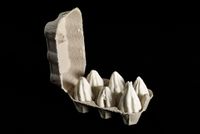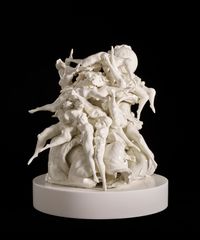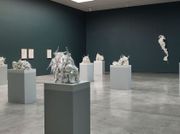Working primarily with porcelain, Rachel Kneebone employs organic forms and art historical references to explore the ideas of life and death, metamorphosis, and bodily experience. Kneebone's sculptures appear to be in perpetual motion, alluding to the human condition.
Read MoreRachel Kneebone discovered porcelain in 2002. She became fascinated with the blankness of its white colour, and the subsequent ambiguity that allows 'whoever is looking at the work to find their own meaning,' as the artist told Studio International in 2021.
Kneebone models clay to suggest entangled limbs and organic motifs such as flowers, twisted vines, and tendrils. When taken together, the smaller parts of sculptures appear to be multiplying into an infinite mass. Imperfections visible in the surface of the porcelain are products of unplanned happenings inside the kiln, which strengthen the dynamism of Kneebone's works.
Rachel Kneebone's sculptures often reference Old Master paintings and classical sculpture. The 'Raft of the Medusa' series (2015), for example, draws on the 19th-century painter Théodore Géricault's painting of the same name, which was inspired by the devastating accounts of the wreck of a frigate in 1816. Mounted on Corian bases, human arms and legs conjoin in Kneebone's works, forming piles of bodies precariously holding onto one another.
Ovid in Exile, Kneebone's solo exhibition at White Cube Hong Kong in 2017, presented a group of sculptures and drawings based on Metamorphoses, a 9th-century collection of myths and historical accounts by the Roman poet Ovid. While consisting of the intricate limbs and tendrils characteristic of Kneebone's practice, the sculptures also feature spherical forms, whose smooth surface provides stability to the otherwise chaotic compositions.
Among Rachel Kneebone's most known works is 399 Days, a five-metre-tall sculpture comprising 63 exterior panels that each shows detailed scenes of clustered body parts and foliage. The porcelain tower echoes Trajan's Column, a triumphal column that commemorates Roman emperor Trajan's victory against the Dacians. Unlike the original column's finely detailed narratives, however, the figures in Kneebone's panels are frenetic and incomprehensible.
399 Days was exhibited alongside works in the Medieval and Renaissance Collection of the Victoria & Albert Museum, London between 2017 and 2019. It is currently on view at Yorkshire Sculpture Park until April 2022.
In 2018, Rachel Kneebone collaborated with choreographer T.C. Howard to present The Dance Project, an exhibition and performance at Touchstones in Rochdale. Sculptures such as Whirl or Dance (both 2017) imitate the movements of dance, recalling photographs of dancers and choreographers Merce Cunningham and Mary Wigman, among others.
Rachel Kneebone has exhibited internationally, holding solo exhibitions such as Raft, White Cube, London (2021); The Dance Project, Touchstones, Rochdale (2018); Raft of the Medusa, Foundling Museum, London (2017); Regarding Rodin, Brooklyn Museum, New York (2012); Still Life, Daniel Blau, Munich (2011); and Rachel Kneebone, Madder Rose Gallery, London (2006).
Selected group exhibitions include Human Condition of Clay, Chapter Arts, Cardiff (2021); The Precious Clay, Museum of Royal Worcester (2018); Dreamers Awake, White Cube, London (2017); KILN, Leila Heller Gallery, New York (2014); Archetypes, Timothy Taylor Gallery, London (2011); Living in Evolution, Busan Biennale (2010); The Beauty of Distance, 12th Biennale of Sydney (2010).
Sherry Paik | Ocula | 2021






